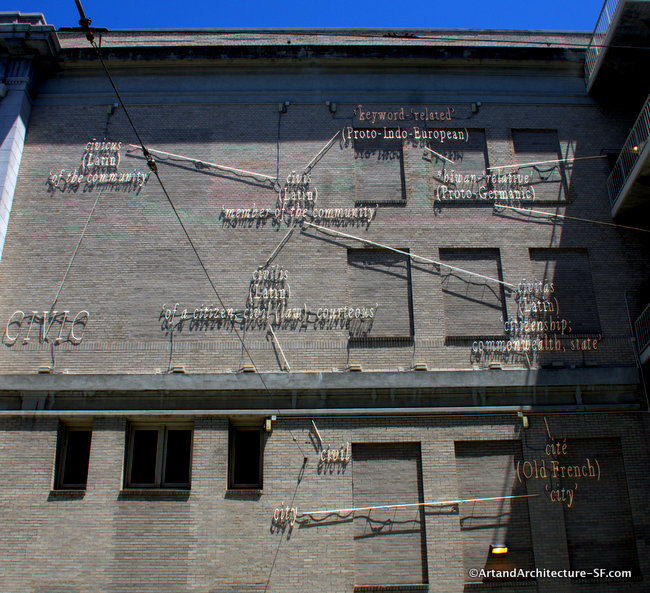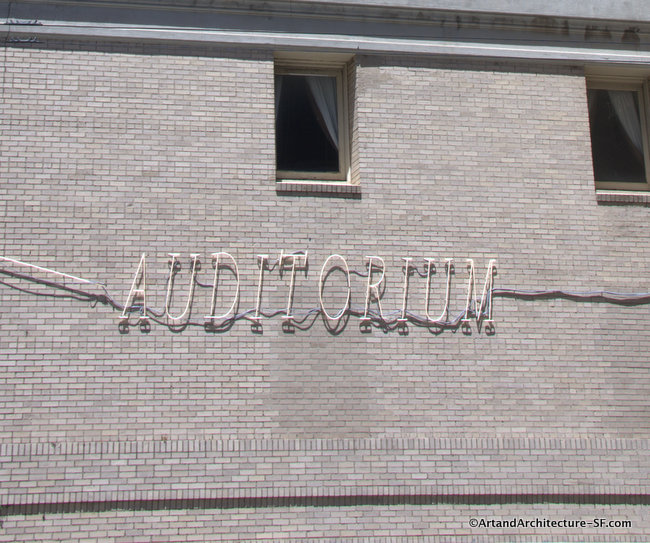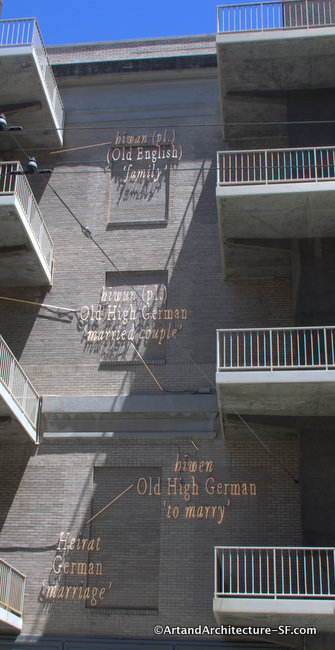Polk Street
Between Hayes and Grove

Photo from Hoodline.com
Conceptual artist Joseph Kosuth’s is the artist behind this neon work on the western side of the Bill Graham Civic Auditorium. Kosuth’s work was selected by the San Francisco Arts Commission (SFAC) in 2015, to be the first public art project funded through the Public Art Trust with the contribution made by The Emerald Fund.
 The Emerald Fund was responsible for two residential buildings that have views of this art piece. The Public Art Trust provides private developers with projects in various zoning districts options regarding the use of their 1%-for-art requirement. Developers may contribute all or a portion of their requirement to the Public Art Trust to be used at the discretion of the San Francisco Arts Commission.
The Emerald Fund was responsible for two residential buildings that have views of this art piece. The Public Art Trust provides private developers with projects in various zoning districts options regarding the use of their 1%-for-art requirement. Developers may contribute all or a portion of their requirement to the Public Art Trust to be used at the discretion of the San Francisco Arts Commission.

*
Joseph Kosuth (born in Toledo Ohio, January 31, 1945), is an American conceptual artist living in New York and London. He studied at the Toledo Museum School of Design at the age of ten and continued there until 1962, during which time he studied with the Belgian painter Line Bloom Draper. Kosuth enrolled at the Cleveland Institute of Art in 1963 and studied drawing and painting there for a year. After traveling abroad for a year, he moved to New York City in 1965 and enrolled at the School of Visual Arts, where he studied painting until 1967. Kosuth was one of the originators of Conceptual art in the mid-1960s, which became a major movement that thrived into the 1970s and remains influential to this day.

Kosuth pioneered the use of words in place of visual imagery. His series of One and Three installations (1965), in which he assembled an object, a photograph of that object, and an enlarged photographic copy of the dictionary definition of it, explored these relationships directly. His enlarged photostats of dictionary definitions in his series Art as Idea as Idea (1966-68) eliminated objects and images completely in order to focus on meaning conveyed purely with language. Since the 1970s, he has made numerous site-specific installations that continue to explore how we experience, comprehend, and respond to language.
 According to Kosuth, “The essence of this building and the historic plaza of which it is part is what I have tried to address in this public artwork. The basis of this project is language itself. It is a work that is both a reflection on its own construction as well as on the history and culture of its own location…
According to Kosuth, “The essence of this building and the historic plaza of which it is part is what I have tried to address in this public artwork. The basis of this project is language itself. It is a work that is both a reflection on its own construction as well as on the history and culture of its own location…
The structure of this installation has two parts: the etymology of the words ‘Civic’ and ‘Auditorium’ in white neon on the western façade. The word ‘Civic’ is intricately connected to the long history of civil rights activism that has taken place (and continues to take place) in the plaza–from Gay Rights to Black Lives Matter. The word ‘Auditorium’ on the other hand is more specific to the building itself, referring to the collective audience assembled by Bill Graham, who found a way, as a concert promoter to not only promote concerts but also community. It is only in the present when a word is used, as it is with a work of art being experienced, that all which comprises the present finds its location in the process of making meaning. Here, in this work, language becomes both an allegory and an actual result of all of which it would want to speak.”

Kosuth believed that images and any traces of artistic skill and craft should be eliminated from art so that ideas could be conveyed as directly, immediately, and purely as possible. There should be no obstacles to conveying ideas, and so images should be eliminated since he considered them obstacles. This notion became one of the major forces that made Conceptual art a movement.

*
*